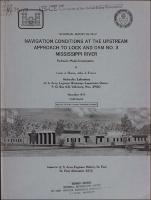Please use this identifier to cite or link to this item:
https://hdl.handle.net/11681/13634Full metadata record
| DC Field | Value | Language |
|---|---|---|
| dc.contributor | United States. Army. Corps of Engineers. St. Paul District | - |
| dc.contributor.author | Shows, Louis J. | - |
| dc.contributor.author | Franco, John J. | - |
| dc.date.accessioned | 2016-08-18T19:14:55Z | - |
| dc.date.available | 2016-08-18T19:14:55Z | - |
| dc.date.issued | 1979-11 | - |
| dc.identifier.uri | http://hdl.handle.net/11681/13634 | - |
| dc.description | Technical Report | - |
| dc.description | Abstract: The Lock and Dam No. 3 navigation structure is located on the upper Mississippi River at about mile 797 above the mouth of the Ohio River and 44.2 miles above Lock and Dam No. 4. The structure is designed to maintain a minimum upper pool during low flows extending 18.3 miles upstream to Lock and Dam No. 2 on the Mississippi River and approximately 52 miles up the St. Croix River. The section of pool extending into the upper Mississippi River provides water access to Minneapolis and St. Paul, Minnesota. The four-gated spillway section is located in the main river channel, and the lock with clear chamber dimensions of 110 by 600 ft and the upper lock gates for a proposed second lock are located in a bypass canal on the right overbank. A fixed-bed model reproducing about 2 miles of the Mississippi River channel, upstream lock approach, a portion of Sturgeon Lake, and adjacent overbank areas to an undistorted scale of 1:120 was used to determine the adequacy of the proposed plan and to develop modifications required to eliminate any adverse conditions indicated. The model investigation was concerned principally with navigation conditions in the upstream approach to the lock, the development of modifications required to improve navigation conditions in the upper lock approach, and the effects of the modifications on the movement of ice and debris. Results of the investigation revealed that satisfactory navigation conditions in the upper lock approach could be developed by replacement of the guide wall with a guard wall with some excavation along the right bank or with a rock dike extending upstream from the right abutment wall of the dam. Ice gaps or openings would be required to reduce the accumulation of ice in the lock approach with either of the plans. NOTE: This file is large. Allow your browser several minutes to download the file. | - |
| dc.publisher | Hydraulics Laboratory (U.S.) | - |
| dc.publisher | Engineer Research and Development Center (U.S.) | - |
| dc.relation | http://acwc.sdp.sirsi.net/client/en_US/search/asset/1033566 | - |
| dc.relation.ispartofseries | Technical report (U.S. Army Engineer Waterways Experiment Station) ; HL-79-17. | - |
| dc.rights | Approved for public release; distribution is unlimited. | - |
| dc.source | This Digital Resource was created from scans of the Print Resource | - |
| dc.subject | Fixed-bed models | - |
| dc.subject | Mississippi River | - |
| dc.subject | Hydraulic models | - |
| dc.subject | Navigation conditions | - |
| dc.subject | Lock and Dam No. 3, Mississippi River | - |
| dc.subject | Locks | - |
| dc.subject | Waterways | - |
| dc.subject | Hydraulic structures | - |
| dc.subject | Inland navigation | - |
| dc.title | Navigation conditions at the upstream approach to Lock and Dam No. 3, Mississippi River : hydraulic model investigation | - |
| dc.type | Report | en_US |
| Appears in Collections: | Technical Report | |
Files in This Item:
| File | Description | Size | Format | |
|---|---|---|---|---|
| TR-HL-79-17.pdf | 11.6 MB | Adobe PDF |  View/Open |